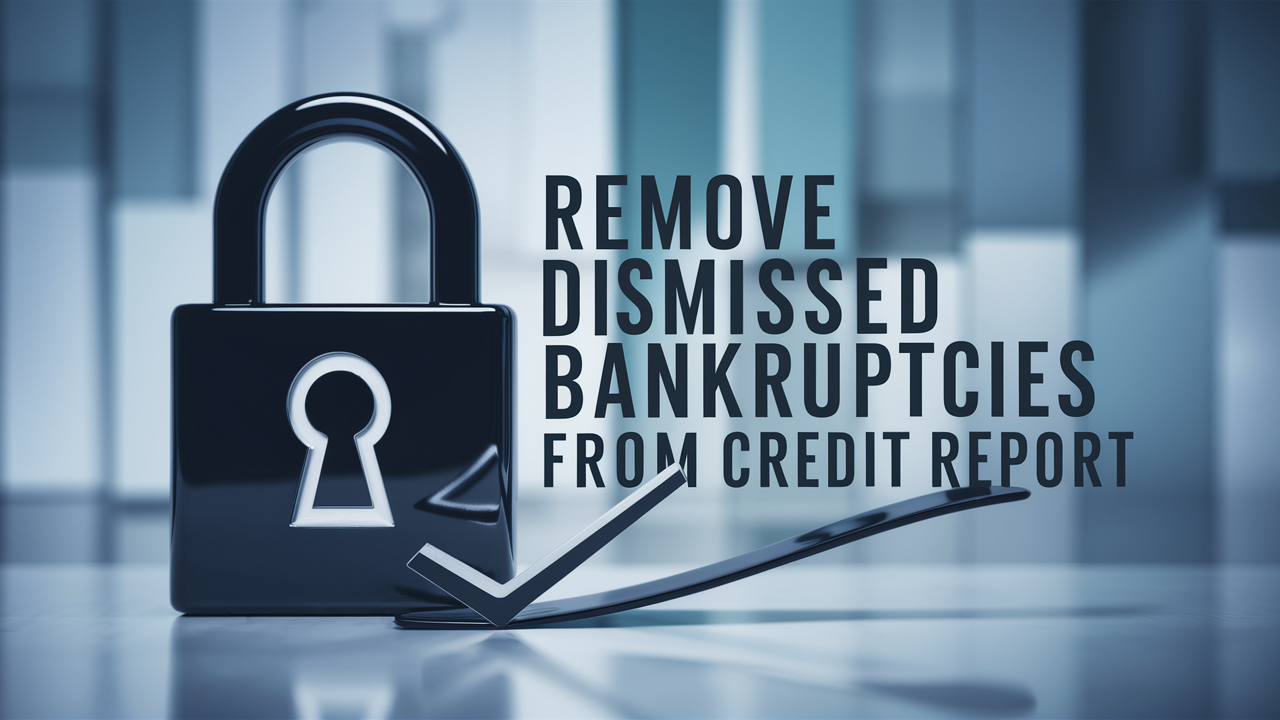How To Get Things Off Your Credit Report?
Understanding how to remove inaccuracies or unwanted items from your credit report is crucial for financial health. This guide provides a comprehensive, step-by-step approach to disputing errors, understanding your rights, and effectively managing your credit history for a stronger financial future.
Understanding Your Credit Reports
Your credit report is a detailed history of your borrowing and repayment activities. It's compiled by credit bureaus, primarily Equifax, Experian, and TransUnion. Lenders, landlords, insurers, and even potential employers use this information to assess your creditworthiness. Understanding its components is the first step in managing it effectively.
The Three Major Credit Bureaus
In the United States, three main credit bureaus collect and maintain credit information:
- Equifax: One of the oldest and largest credit bureaus.
- Experian: Another major player with a vast database of consumer credit information.
- TransUnion: The third of the "big three," also holding extensive credit histories.
Each bureau may have slightly different information because creditors report to them independently. Therefore, it's essential to check your report from all three to get a complete picture.
Key Components of a Credit Report
A typical credit report includes several sections:
- Personal Information: Your name, address, Social Security number, and employment history. This is often the first place errors appear.
- Credit Accounts: A list of all your credit accounts, including credit cards, mortgages, auto loans, and student loans. For each, you'll see the lender, account number (often partially masked), date opened, credit limit or loan amount, balance, and payment history.
- Credit Inquiries: A record of who has accessed your credit report. "Hard inquiries" occur when you apply for credit and can slightly lower your score. "Soft inquiries" (like checking your own credit) do not affect your score.
- Public Records: Information from public sources, such as bankruptcies, liens, and judgments.
The Importance of Credit Scores
While not part of the report itself, your credit score is derived from the information within it. Scores like FICO and VantageScore range from 300 to 850. A higher score indicates lower risk to lenders, leading to better interest rates and loan terms. By 2025, the average FICO score in the U.S. is projected to remain strong, hovering around 715-720, but individual scores can vary significantly based on report accuracy and financial habits. A clean credit report is fundamental to achieving and maintaining a good credit score.
Identifying Errors on Your Credit Report
Errors on credit reports are surprisingly common. They can range from minor inaccuracies to significant mistakes that negatively impact your credit score. Proactive checking is key to catching these issues before they cause serious financial harm.
Common Types of Errors
Errors can manifest in various ways. Here are some of the most frequent culprits:
- Incorrect Personal Information: Your report might contain someone else's accounts if your name and Social Security number are similar, or if you've lived at an address previously occupied by someone with a similar name.
- Inaccurate Account Balances: The reported balance on a credit card or loan might be wrong, either too high or too low.
- Incorrect Payment History: Payments that were made on time might be reported as late, or vice versa. This is one of the most damaging types of errors.
- Accounts You Don't Recognize: This could indicate identity theft or simply an error where an account is mistakenly linked to you.
- Duplicate Accounts: The same account appearing multiple times on your report.
- Closed Accounts Still Showing as Open: Or vice versa.
- Outdated Information: Negative information that is past the legally permissible reporting period (typically seven years for most negative items, ten years for bankruptcies) should have been removed but hasn't been.
How to Obtain Your Credit Reports
You are entitled to a free copy of your credit report from each of the three major bureaus annually. The official website for this is AnnualCreditReport.com. Due to the COVID-19 pandemic and its lingering effects, you can currently access your reports weekly for free from each bureau.
Steps to get your reports:
- Visit AnnualCreditReport.com.
- Click on "Request Your Credit Reports."
- Follow the prompts to verify your identity. You'll typically need to provide personal information that the bureaus can match against your existing records.
- Once verified, you can choose to view your reports online or download them.
- Repeat this process for Equifax, Experian, and TransUnion.
What to Look For When Reviewing
When you receive your reports, go through them with a fine-tooth comb. Pay close attention to:
- Personal Details: Ensure your name, address history, and Social Security number are correct.
- Account Status: Verify that all account details (balances, credit limits, dates opened) are accurate.
- Payment History: Check that each payment is marked correctly (current, late, paid off).
- Inquiries: Review hard inquiries to ensure you authorized each one.
- Public Records: Confirm any public records listed are accurate and, if applicable, have aged out of reporting.
Keep a checklist or a spreadsheet to track any discrepancies you find. Note the account name, account number, the specific error, and the date you noticed it.
Your Rights as a Consumer
The Fair Credit Reporting Act (FCRA) is the cornerstone of your rights regarding credit reports. It ensures accuracy, fairness, and privacy in the handling of your credit information. Understanding these rights empowers you to effectively dispute errors.
The Fair Credit Reporting Act (FCRA)
The FCRA, enacted in 1970 and amended over the years, dictates how credit bureaus and furnishers of credit information must operate. Key provisions include:
- Accuracy: Credit bureaus must ensure the information they collect and report is accurate.
- Dispute Rights: You have the right to dispute any information on your credit report that you believe is inaccurate or incomplete.
- Investigation: When you dispute information, the credit bureau must investigate your claim. They typically have 30 days (sometimes extended to 45) to complete this investigation.
- Furnisher Responsibilities: The entity that provided the information (e.g., your bank, credit card company) must also investigate disputes referred to them by the credit bureau.
- Removal of Inaccurate Information: If information is found to be inaccurate, incomplete, or unverifiable, it must be corrected or removed from your report.
- Reporting Limits: Most negative information can only be reported for seven years, with some exceptions like bankruptcies (ten years).
- Permissible Purpose: Only entities with a legitimate need can access your credit report.
Your Right to Dispute Inaccuracies
This is your most powerful tool. The FCRA explicitly grants you the right to challenge any item on your credit report. This includes:
- Information that is incorrect.
- Information that is incomplete.
- Information that cannot be verified by the furnisher.
You can dispute information with the credit bureau directly, or you can dispute it with the furnisher of the information. Often, it's most effective to do both.
Statute of Limitations on Debt
It's important to distinguish between the reporting period of negative information on your credit report and the statute of limitations for debt collection.
- Reporting Period: As mentioned, most negative items remain on your report for seven years.
- Statute of Limitations: This is the legal timeframe within which a creditor can sue you to collect a debt. This varies by state, typically ranging from 3 to 10 years. Importantly, the statute of limitations for *reporting* a debt is separate from the statute of limitations for *collecting* it. A debt that is too old to be sued for might still appear on your credit report if it's within the reporting period.
By 2025, these statutes remain largely consistent, though state-specific laws should always be consulted.
Identity Theft Protection
If you suspect identity theft, you have additional rights under the FCRA. You can file a police report and provide a copy to the credit bureaus. You can also request that fraudulent information be removed from your report. The bureaus must investigate and block the fraudulent information from appearing on your report.
The Dispute Process: Step-by-Step
Disputing an error on your credit report might seem daunting, but following a structured process makes it manageable and increases your chances of success.
Step 1: Gather Your Documentation
Before you start, collect all relevant documents. This includes:
- Copies of your credit reports from all three bureaus showing the error.
- Any statements, bills, or receipts related to the disputed item.
- Correspondence with the creditor or lender, if any.
- Proof of identity (e.g., driver's license copy, utility bill with your address).
- If applicable, a police report if you suspect identity theft.
Step 2: Decide Whom to Dispute With
You have two primary options:
- Dispute with the Credit Bureau: This is the most common method. You'll file your dispute directly with Equifax, Experian, or TransUnion.
- Dispute with the Furnisher: You can also dispute directly with the company that provided the information to the credit bureau (e.g., your credit card company). This is often called a "direct dispute."
Recommendation: It's often most effective to dispute with both the credit bureau and the furnisher. The credit bureau is required to investigate, and the furnisher is required to investigate when notified by the bureau.
Step 3: Write Your Dispute Letter
Whether you're writing to the bureau or the furnisher, your letter should be clear, concise, and professional. Use certified mail with a return receipt requested to have proof of delivery.
Key elements of a dispute letter:
- Your Information: Full name, address, phone number, and account number (if disputing with the furnisher) or credit report account number (if disputing with the bureau).
- Date: The date you are writing the letter.
- Recipient Information: The correct mailing address for the credit bureau's dispute department or the furnisher.
- Clear Statement of Dispute: State that you are writing to dispute information on your credit report.
- Specific Item(s) in Dispute: Clearly identify the account or item you are disputing. Include the account number as it appears on your report.
- Reason for Dispute: Explain *why* the information is inaccurate or unverifiable. Be specific. For example, "The payment history for account ending in XXXX shows a late payment on [date], but I have attached proof that the payment was made on time on [date]."
- Desired Resolution: State what you want to happen, e.g., "I request that this inaccurate late payment be removed from my credit report."
- Supporting Documents: Mention that you have enclosed copies of supporting documents (never send originals).
- Request for Investigation: "I request that you investigate this matter thoroughly as required by the Fair Credit Reporting Act."
- Closing: "Sincerely," followed by your signature.
Example Snippet for Letter to Bureau:
"To Whom It May Concern, I am writing to dispute the following information appearing on my Equifax credit report, account number [Your Equifax Account Number if available]: Account: [Creditor Name], Account Number: [Account Number as shown on report] Error: The report shows this account as delinquent as of [Date], but my records indicate that all payments were made on time. I have enclosed copies of cancelled checks/payment confirmations showing timely payments for the period in question. I request that you investigate this discrepancy and remove any inaccurate negative information related to this account from my credit report. Please send confirmation of your investigation and findings to the address above."
Step 4: Send Your Letter
Send your letter via certified mail with return receipt requested. This provides proof that your letter was sent and received. Keep copies of everything.
Step 5: Wait for the Investigation
Credit bureaus typically have 30 days to investigate your dispute. They will contact the furnisher of the information to verify its accuracy. If the furnisher cannot verify the information, it must be removed or corrected.
Step 6: Review the Results
After the investigation, the credit bureau will send you a letter detailing their findings and any actions taken. They must also send you an updated copy of your credit report if changes were made.
Types of Items You Can Dispute
Not all items on your credit report are created equal, and some are easier to dispute than others. Understanding what you can and cannot dispute is crucial.
Inaccurate Negative Information
This is the most common and often most successful type of dispute.
- Late Payments: If a payment was actually made on time, dispute it. Provide proof.
- Incorrect Balances: If your balance is reported higher than it is, dispute it.
- Accounts You Never Opened: This is a strong indicator of identity theft or a clerical error. Dispute immediately.
- Collections Accounts: If a debt collector is reporting an account that isn't yours, or if the debt is past the statute of limitations for reporting, dispute it.
- Judgments, Liens, Bankruptcies: If these public records are inaccurate or have expired from your report, dispute them.
Positive Information (Less Common, But Possible)
While less frequent, errors can occur with positive information too.
- Accounts Showing as Closed That Are Open: If you have an open account being reported as closed, this could impact your credit utilization.
- Incorrect Credit Limit: If your credit limit is reported lower than it actually is, this can artificially inflate your credit utilization ratio.
Items You Generally Cannot Dispute (But Can Address)
Some information, while negative, is accurate and cannot be removed simply by disputing it.
- Accurate Late Payments: If you were genuinely late on a payment and the report reflects this accurately, a dispute will likely fail. The best approach here is to ensure timely payments moving forward and wait for the negative mark to age off your report.
- Debts You Owe: If you owe a debt and it's accurately reported, you cannot dispute its existence. The solution is to pay the debt.
- Information Within the Reporting Period: As long as the negative information is accurate and within the FCRA's reporting time limits (usually 7 years), it will remain on your report.
Settled or Paid Debts
If you have settled a debt for less than the full amount or paid it off, it should be reported as such. If it's inaccurately reported as still unpaid or delinquent, dispute it. Even if accurately reported as "paid in full" or "settled," the fact that the debt existed and was resolved negatively (settled) will still impact your score, but less so than an active collection.
Example Scenario: Disputing a Medical Bill
Suppose a medical bill for $500 appears on your credit report as a collection account, but you had insurance that should have covered it, and you never received a bill.
- Obtain Report: Get your credit report showing the collection.
- Gather Proof: Find your insurance policy details and any correspondence with the insurer. Contact the hospital/clinic to get billing statements.
- Contact Insurer: Confirm coverage and that the claim was processed or denied incorrectly.
- Write Dispute Letter: To the credit bureau and/or collection agency. State that the debt is disputed because it should have been covered by insurance and you never received a valid bill. Enclose copies of insurance information and any relevant correspondence.
- Follow Up: Monitor your report for changes.
What If Your Dispute is Denied?
It's not uncommon for disputes to be initially denied, especially if the furnisher has some form of verification. However, denial doesn't always mean the end of the road.
Understanding the Denial
The credit bureau will send you a letter explaining the outcome of their investigation. They might state that the furnisher verified the information. This doesn't necessarily mean the information is correct, just that the furnisher provided some documentation.
Options When a Dispute is Denied
1. Re-Dispute with More Evidence: If you have stronger evidence than you initially provided, you can file a second dispute. This could include:
- Additional statements or receipts.
- Affidavits from yourself or others.
- Expert opinions (rare, but possible for complex issues).
The Role of Credit Repair Organizations
Reputable credit repair services can assist you by:
- Reviewing your credit reports for errors.
- Assisting you in drafting dispute letters.
- Communicating with credit bureaus and creditors on your behalf.
However, they cannot remove accurate information from your report, nor can they guarantee results. Be wary of companies that promise to remove all negative items or charge high upfront fees. The Credit Repair Organizations Act (CROA) provides some consumer protections.
When to Consider Legal Counsel
If you believe a credit bureau or furnisher has knowingly reported inaccurate information, failed to investigate your dispute properly, or violated your rights under the FCRA, you might consider legal action. This is particularly relevant in cases of:
- Identity theft that is not being resolved.
- Significant financial damage caused by reporting errors.
- Repeated FCRA violations.
A consumer protection attorney can advise you on your rights and the feasibility of a lawsuit.
Preventing Future Errors
While you can't prevent all errors, taking proactive steps can significantly reduce their occurrence and impact.
Regularly Monitor Your Credit
As mentioned, get your free reports annually (or weekly for now) from AnnualCreditReport.com. Don't wait for a problem to arise. Make it a habit to review them at least once a year.
Maintain Accurate Personal Information
Ensure your name, address, and Social Security number are correct with all your financial institutions. If you move, update your address with creditors promptly.
Pay Bills On Time
The most significant factor in your credit score is your payment history. Consistently paying bills on time is the best way to build a positive credit report. Set up auto-pay or reminders to avoid missed payments.
Keep Credit Utilization Low
High credit utilization can negatively impact your score. Aim to keep your credit card balances below 30% of their limits, and ideally below 10%.
Be Cautious with New Credit
Each time you apply for new credit, a hard inquiry is added to your report. While one or two inquiries won't drastically lower your score, too many in a short period can signal risk to lenders. Only apply for credit you truly need.
Close Unused Accounts Carefully
Closing old credit card accounts can sometimes negatively impact your credit score by reducing your average age of accounts or increasing your credit utilization. If you decide to close an account, consider keeping the oldest ones open, especially if they have no annual fee.
Understand Your Rights and Responsibilities
Knowledge is power. Familiarize yourself with consumer protection laws like the FCRA and know how to exercise your rights.
Credit Monitoring and Security
Beyond disputing errors, actively monitoring your credit and securing your personal information are vital for maintaining a healthy credit report and protecting yourself from fraud.
Credit Monitoring Services
Many services offer to monitor your credit reports for changes. These services typically alert you when new accounts are opened, significant changes occur in your credit history, or when there are inquiries on your report.
- Free Options: Some credit card companies and banks offer free credit monitoring as a perk to their customers.
- Paid Services: Services like Credit Karma, Credit Sesame, and more comprehensive paid services (e.g., from the credit bureaus themselves or third parties like LifeLock) provide detailed monitoring and alerts.
While these services are helpful for detecting potential fraud or errors early, they are not a substitute for periodically reviewing your actual credit reports from AnnualCreditReport.com.
Identity Theft Protection
Protecting your Social Security number and other personal information is paramount.
- Secure Your Mail: Use a locked mailbox or pick up mail promptly.
- Shred Documents: Shred sensitive documents before discarding them.
- Strong Passwords: Use strong, unique passwords for online accounts and enable two-factor authentication where available.
- Be Wary of Phishing: Never click on suspicious links in emails or text messages, and never provide personal information in response to unsolicited requests.
- Monitor Bank Statements: Regularly review your bank and credit card statements for any unauthorized transactions.
Credit Freezes and Fraud Alerts
If you are a victim of identity theft or are concerned about potential fraud, you can place a credit freeze or fraud alert on your credit reports.
- Fraud Alert: This requires lenders to take extra steps to verify your identity before extending credit. It lasts for one year and can be renewed. It also entitles you to one free credit report from each bureau.
- Credit Freeze (Security Freeze): This restricts access to your credit report, making it much harder for identity thieves to open new accounts in your name. You'll need to temporarily "unfreeze" your credit if you plan to apply for credit yourself. As of 2025, credit freezes are free for consumers nationwide.
To place a fraud alert or credit freeze, you need to contact each credit bureau individually.
The Future of Credit Reporting (2025 and Beyond)
The credit reporting landscape is constantly evolving. By 2025, we continue to see trends towards greater consumer access and control. Initiatives like the free weekly reports are a testament to this. Expect ongoing discussions and potential regulatory changes aimed at improving accuracy and fairness in credit reporting. Staying informed about these changes will help you leverage your rights effectively.
Removing inaccuracies from your credit report is a vital step toward financial well-being. By understanding your rights under the FCRA, meticulously reviewing your credit reports, and following a structured dispute process, you can effectively address errors. Remember to gather documentation, write clear dispute letters, and follow up diligently. If disputes are denied, explore re-disputing, adding consumer statements, or seeking professional assistance. Proactive monitoring and robust security measures are your best defenses against future errors and identity theft. Take control of your credit report today for a stronger financial tomorrow.
Related Stories
Recent Posts
Does Closing a Checking Account Affect Your Credit Score? Here’s the Truth
Is a Home Equity Loan a Second Mortgage? The Definitive 2025 Guide
Which Credit Score is Most Accurate? FICO vs VantageScore
Does Closing a Checking Account Affect Credit Score? – Complete Guide for Consumers
Credit Captain Reviews (2025): Is It Legit, Safe, and Worth It?



